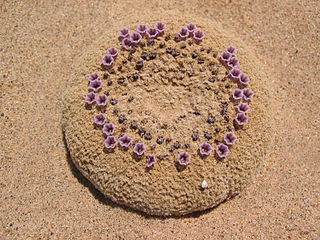
Pholisma sonorae, commonly known as sandfood, is a rare and unusual species of flowering plant endemic to the Sonoran Deserts to the west of Yuma, Arizona in the California Yuha, Mojave Desert and Colorado Desert, and south in the Yuma Desert, where it is known from only a few locations.

Eriogonum nudum is a perennial shrub of the wild buckwheat genus which is known by the common name naked buckwheat or nude buckwheat.
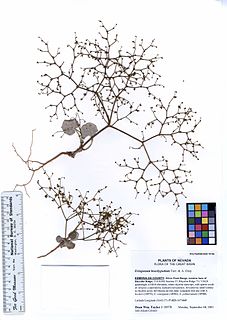
Eriogonum brachypodum is a species of wild buckwheat known by the common name Parry's buckwheat. This annual herb is native to the southwestern United States from California to Utah and especially the Mojave Desert. It grows in sandy and gravelly substrates. It has a skeletonlike spindly stem which branches many times. It can grow 5 to 50 centimeters in height and up to a meter in width. There is an array of rounded, dark-colored leaves around the base. Leaves are a few centimeters long and fuzzy on the undersides. Most of the plant is actually the spreading inflorescence. At intervals on the otherwise naked branches hang tiny clusters of glandular flowers a few millimeters wide in involucres of bell-shaped bracts. Each flower is less than three millimeters wide.

Eriogonum wrightii is a species of wild buckwheat known by the common names bastardsage and Wright's buckwheat. It is native to the Southwestern United States, California, and northwest Mexico, where it grows in many plant communities, such as chaparral, in rocky habitats from mountains to deserts.
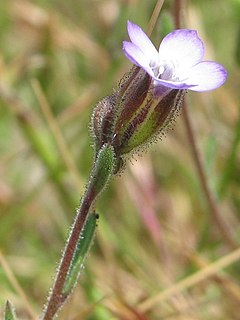
Gilia millefoliata is a species of flowering plant in the phlox family known by the common name manyleaf gilia. It is native to the coastline of Oregon and northern California, where it grows in sand dune habitat.
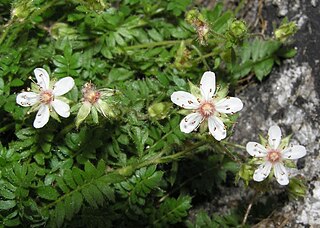
Ivesia callida is a rare species of flowering plant, in the rose family, known by the common name Tahquitz mousetail. It is a small perennial herb which forms matted patches of hanging foliage on cliff faces. The leaves are strips of oval-shaped green leaflets. Each leaf is up to 7 centimeters long and has several pairs of hairy, glandular leaflets. The thin, green, hanging stems grow up to 15 centimeters long and bear an inflorescence of several flowers. Each flower has five hairy, pointed sepals and five round to oval white petals. The center of the flower contains twenty stamens with disc-shaped anthers and several pistils.
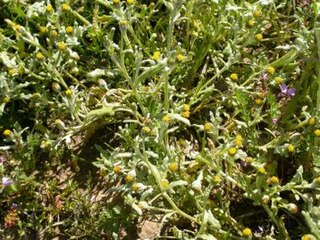
Monolopia congdonii is a rare species of flowering plant in the family Asteraceae known by the common name San Joaquin woollythread. It is endemic to California, where it is known only from the southern San Joaquin Valley and one area in nearby Santa Barbara County. It is a federally listed endangered species.

Eriogonum angulosum is a species of wild buckwheat known by the common name anglestem buckwheat.

Eriogonum eremicola is a rare species of wild buckwheat known by the common names Telescope Peak buckwheat and Wild Rose Canyon buckwheat. It is endemic to Inyo County, California, where it is known from only a few occurrences in the Inyo Mountains and Telescope Peak in Death Valley. It grows in sandy to rocky habitat in the forests and woodlands of these desert mountains. It is an annual herb producing a spreading, glandular, reddish green stem up to about 25 centimeters tall. The rounded, woolly leaves are up to about 2.5 centimeters long and are located at the base of the stem. The scattered inflorescences are small clusters of tiny flowers which are white with reddish stripes, aging to solid red, or sometimes yellow. The plant is under protection in Death Valley National Park.
Eriogonum gossypinum is an uncommon species of wild buckwheat known by the common name cottony buckwheat. It is endemic to California, where it is known from the southern Central Valley and some of the adjacent foothills. It is often found on clay soils. It is an annual herb producing a gray or reddish branched stem no more than about 20 centimeters tall. The leaves are oblong in shape and woolly in texture. The scattered inflorescences are small clusters of white to pink glandular flowers buried in a layer of cottony fibers.
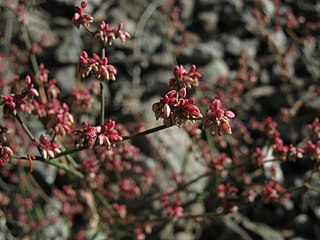
Eriogonum hoffmannii is a species of wild buckwheat known by the common name Hoffmann's buckwheat. It is endemic to Inyo County, California, where it is found only in the mountains around Death Valley; most of the known populations of the plant are located in Death Valley National Park. The plant grows in the desert scrub on the slopes of the Panamint, Black, and Funeral Mountains.
Eriogonum molestum is a species of wild buckwheat known by the common name pineland buckwheat. It is endemic to southern California, where it grows in the Transverse Ranges of Ventura County to the Peninsular Ranges of San Diego County.

Blepharizonia is a genus of flowering plants in the family Asteraceae. There are two species, both endemic to California. They are known generally as big tarweeds.
Ribes canthariforme is a rare North American species of currant known by the common name Moreno currant.
Ribes victoris is an uncommon North American species of currant known by the common name Victor's gooseberry. It is endemic to California, where it grows in the chaparral and woods of canyons in the San Francisco Bay Area and counties to the north, as far as Humboldt County.
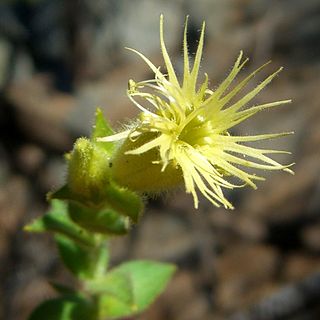
Silene parishii is a species of flowering plant in the family Caryophyllaceae known by the common name Parish's catchfly. It is endemic to southern California, where it is known from several of the local mountain ranges, including the San Bernardino, San Gabriel, and San Jacinto Mountains. It grows in rocky, forested habitat, sometimes in the alpine climates of the higher peaks. It is a perennial herb growing from a woody, branching caudex and taproot, sending up several decumbent or erect stems 10 to 40 centimetres tall. The oppositely arranged leaves line the stems, the largest ones located at the middle of each stem. Leaves are lance-shaped to nearly oval and up to 6 centimetres long. They are thick and leathery, and sometimes glandular and sticky. Each flower is encapsulated in a tubular calyx of fused sepals which may be nearly 3 centimetres long. It is greenish with ten veins and a coating of glandular hairs. The five petals are yellowish in colour and each has about six long, fringelike lobes at the tip.

Eriogonum spectabile is a rare species of wild buckwheat known by the common name Barron's buckwheat. It is endemic to Plumas County, California, where it is known from two occurrences in Lassen National Forest near Chester. There are approximately 250 individuals in existence. It grows in scrubby, forested mountain habitat, only on glaciated andesite substrates. This rare plant was discovered in 1997 and described to science as a new species in 2001.
Eriogonum crosbyae is a species of wild buckwheat known by the common name Crosby's buckwheat. It is native to southcentral Oregon and northwestern Nevada in the United States. Some treatments include plants in Montana and Idaho as members of this species. This plant was first discovered in the Guano Valley in Lake County, Oregon, in 1978 by Bureau of Land Management botanist Virginia Crosby, and it was named for her in 1981.

Deinandra mohavensis, commonly known as Mojave tarplant or Mojave tarweed, is a species of flowering plant in the family Asteraceae.

Eriogonum preclarum, known commonly as the Puerto Nuevo buckwheat, is a very rare species of perennial wild buckwheat in the family Polygonaceae. It is endemic to the Vizcaíno Peninsula in Baja California Sur, occurring on ultramafic substrates.














